
Ficus macrophylla, commonly known as the Moreton Bay fig or Australian banyan, is a large evergreen banyan tree of the Mulberry Family (Moraceae) native to eastern Australia, from the Wide Bay–Burnett region in the north to the Illawarra in New South Wales, as well as Lord Howe Island where the subspecies F. m. columnaris is a banyan form covering 2.5 acres or more of ground. Its common name is derived from Moreton Bay in Queensland, Australia. It is best known for its imposing buttress roots.

Say's phoebe is a passerine bird in the tyrant flycatcher family, Tyrannidae. A common bird across western North America, it prefers dry, desolate areas. It was named for Thomas Say, an American naturalist.
Glowworm or glow-worm is the common name for various groups of insect larvae and adult larviform females that glow through bioluminescence. They include the European common glow-worm and other members of the Lampyridae, but bioluminescence also occurs in the families Elateridae, Phengodidae and Rhagophthalmidae among beetles; as well as members of the genera Arachnocampa, Keroplatus and Orfelia among keroplatid fungus gnats.

The eastern or Queensland tube-nosed bat is a megabat in the family Pteropodidae that lives in north-eastern Australia. N. robinsoni is one of the few species of megabat that roosts solitarily. They get their common name from their raised tubular nostrils which are unlike those of most other species in the family. They are a deep brown with gray heads and sparse yellow spotting.

Eupoecila australasiae, commonly known as the fiddler beetle or rose chafer, is a colourful green- or yellow-and-black member of the scarab beetle family from eastern Australia.

Coxen's fig parrot, also known as the blue-browed, red-faced or southern fig parrot or lorilet, is one of the smallest and least known Australian parrots. It is a highly endangered subspecies of the double-eyed fig parrot. It was named by John Gould after his brother-in-law Charles Coxen.
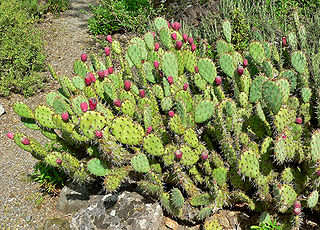
Opuntia, commonly called the prickly pear cactus, is a genus of flowering plants in the cactus family Cactaceae, many known for their flavorful fruit and showy flowers. Cacti are well-adapted to aridity; however, they are still vulnerable to alterations in precipitation and temperature driven by climate change. Prickly pear alone is more commonly used to refer exclusively to the fruit, but may also be used for the plant itself; in addition, other names given to the plant and its specific parts include tuna (fruit), sabra, sabbar, nopal from the Nahuatl word nōpalli, nostle (fruit) from the Nahuatl word nōchtli, and paddle cactus. The genus is named for the Ancient Greek city of Opus, where, according to Theophrastus, an edible plant grew and could be propagated by rooting its leaves. The most common culinary species is the "Barbary fig".

Phycosecidae is a family of beetles in the superfamily Cleroidea., containing the single genus Phycosecis found in Australia, New Caledonia, New Zealand and Vanuatu. The beetles are small, about 1.5–3.5 mm in length. They live in sandy coastal areas, and are saprophagous, feeding on faeces, carrion, and dead arthropods during the daytime.
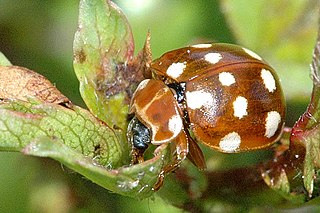
Calvia quatuordecimguttata, the cream-spot ladybird, is a species of ladybird in the family Coccinellidae. Its distribution is holarctic, it being found in Europe and through the East Palearctic to Japan. It is introduced to North America. This ladybird is generally 4 to 5 millimetres in length and varies in appearance depending on the geographical location. It usually lives in hedgerows and deciduous trees.

Eupoecila is a genus of scarab beetle family that includes five species, all of which are found in Australia.

Eupoecila inscripta is a species of scarab beetle in the genus Eupoecila, found in western Australia.

Eupoecila intricata, is a rare species of the Australian-endemic scarab beetle genus Eupoecila. E.intricata was described by Lea (1914) as a subspecies of E. australasiae and is still often confused with the species. It was raised to species status by Allard (1995).
Caladenia evanescens, commonly known as the semaphore spider orchid, is a species of orchid endemic to a small area near Albany in the south-west of Western Australia. It is a rare species with a single, hairy leaf and one or two cream-coloured to greenish-cream flowers.
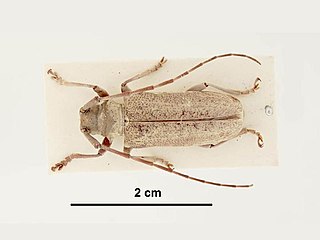
Acalolepta vastator is a species of beetle in the family Cerambycidae. It was described by Newman in 1841, originally under the genus Monohammus. Breuning erroneously synonymised this species with Acalolepta mixta. It is found throughout eastern Australia, including Tasmania and South Australia, as well as parts of South Asia. The Australian government recognize this species as a pest species. It feeds on grape vine, papaya and curtain fig tree.
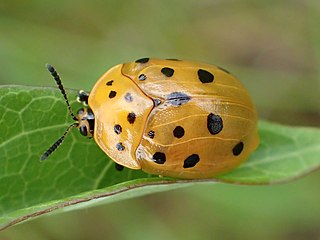
Chelymorpha cassidea, known generally as the Argus tortoise beetle or milkweed tortoise beetle, is a species of leaf beetle in the family Chrysomelidae. It is found in the Caribbean and North America.
Eboo is a genus of leaf beetles in the subfamily Eumolpinae. It is endemic to Australia, and contains approximately 50 species. Many of these species show strong sexual dimorphism, and they feed primarily on Eucalyptus plants.

Spilopyra is a genus of leaf beetles in the subfamily Spilopyrinae. It is found in eastern Australia and New Guinea.

Lamprolina is an Australian genus of leaf beetles (Chrysomelidae) found in Victoria, New South Wales, and Queensland.
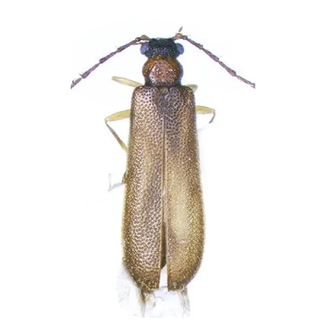
Binburrum articuno is a species of beetle which in the taxonomy field is classified under the genus Binburrum. It exists only in Australia. It is named after the fictional creature known as Articuno from the pop culture franchise Pokémon. It was named alongside other beetles from the same genus, Binburrum zapdos and Binburrum moltres, by Darren Pollock and Yun Hsiao. Because their names are based on a very popular franchise, these species saw above average media coverage upon being named.















